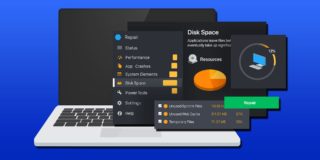A detailed history of the processor
AM486DX Series (1994 – 1995)
Intel was not the only manufacturer playing in the sandbox at the time. AMD put out its AM486 series in answer to Intel’s counterpart. AMD released the chip in AM486DX4/75, AM486DX4/100, and AM486DX4/120 versions. It contained on-board cache, power management features, 3-volt operation and SMM mode. This made the chip fitting for mobiles in addition to desktops. The chip found its way into many 486-compatibles.
AMD AM5x86 (1995)
This is the chip that put AMD onto the map as official Intel competition. While I am mentioning it here on the 486 page of the history lesson, it was actually AMD’s competitive response to Intel’s Pentium-class processor. Users of the Intel 486 processor, in order to get Pentium-class performance, had to make use of an expensive OverDrive processor or ditch their motherboard in favor of a true Pentium board. AMD saw an opening here, and the AM5x86 was designed to offer Pentium-class performance while operating on a standard 486 motherboard.. They did this by designing the 5×86 to run at 133MHz by clock-quadrupling a 33 MHz chip. This 33 MHz bus allowed it to work on 486 boards. This speed also allowed it to support the 33 MHz PCI bus. The chip also had 16 KB on-die cache. All of this together, and the 5×86 performed better than a Pentium-75. The chip became the de facto upgrade for 486 users who did not want to ditch their 486-based PCs yet.
The Pentium (1993)
By this time, the Intel 486 was entrenched into the market. Also, people were used to the traditional 80×86 naming scheme. Intel was busy working on its next generation of processor. It was not to be called the 80586, though. There were some legal issues surrounding the ability for Intel to trademark the numbers 80586. So, instead, Intel changed the name of the processor to the Pentium, a name they could easily trademark. They released the Pentium in 1993. The original Pentium performed at 60 MHz and 100 MIPS. Also called the “P5” or “P54”, the chip contained 3.21 million transistors and worked on the 32-bit address bus (same as the 486). It has a 64-bit external data bus which could operate at roughly twice the speed of the 486.
The Pentium family includes the 60/66/75/90/100/120/133/150/166/200 MHz clock speeds. The original 60/66 MHz versions operated on the Socket 4 setup, while all of the remaining versions operated on the Socket 7 boards. Some of the chips (75MHz – 133MHz) could operate on Socket 5 boards as well. Pentium is compatible with all of the older operating systems including DOS, Windows 3.1, Unix, and OS/2. Its superscalar design can execute two instructions per clock cycle. The two separate 8K caches (code cache and data cache) and the pipelined floating point unit increase its performance beyond the x86 chips. It had the SL power management features of the i486SL, but the capability was much improved. It has 273 pins that connect it to the motherboard. Internally, though, its really two 32-bit chips chained together that split the work. The first Pentium chips operated at 5 volts and thus operated rather hotly. Starting at the 100MHz version, the requirement was reduced to 3.3 volts. Starting at the 75MHz version, the chip also supported Symmetric Dual Processing, meaning you could use two Pentiums side by side in the same system.
The Pentium stayed around a long time. It was released in many different speeds as well as different flavors. In fact, Intel implemented an “s-spec” rating which is marked on each Pentium CPU which tells the owner some key data about the processor in order to make sure they have their motherboard set correctly. There were just so many different Pentiums out there that it became hard to tell. You can look up processor specs using the s-spec at the link below.
Related Link: Intel Processor Spec Finder
The Pentium Pro (1995-1999)
If the regular Pentium is an ape, this processor evolved into being human. The Pentium Pro (also called “P6” or “PPro”) is a RISC chip with a 486 hardware emulator on it, running at 200 MHz or below. Several techniques are used by this chip to produce more performance than its predecessors. Increased speed is achieved by dividing processing into more stages, and more work is done within each clock cycle. Three instructions can be decoded in each clock cycle, as opposed to only two for the Pentium. In addition, instruction decoding and execution are decoupled, meaning that instructions can still be executed if one pipeline stops (such as when one instruction is waiting for data from memory; the Pentium would stop all processing at this point). Instructions are sometimes executed out of order, that is, not necessarily as written down in the program, but rather when information is available, although they won’t be much out of sequence; just enough to make things run smoother. Such improvements to the PPro resulted in a chip optimized for higher end desktop workstations and network servers.
It has two separate 8K L1 cache (one for data and one for instructions), and up to 1 MB of onboard L2 cache in the same package. the onboard L2 cache increased performance in and of itself because the chip did not have to make use of an L2 cache on the motherboard itself. PPro is optimized for 32-bit code, so it will run 16-bit code no faster than a Pentium, which is a big drawback. It’s still a great processor for servers, being it can be in multiprocessor systems with 4 processors. Another good thing about the Pentium Pro is that with the use of a Pentium 2 overdrive processor, you have all the perks of a normal Pentium II, but the L2 cache is full speed, and you get the multiprocessor support of the original Pentium Pro.
Click here: Next Page





















30 thoughts on “A detailed history of the processor”
In fact, the 8080 external interface was distinctly different from the 8086, in idea, not just width – for example, 8080 pin 21 (DMA acknowledge).
The 8086 was (almost) binary compatible with the 8080 for “regular programs” ie: not ones that twiddled ports nor relied on specific interrupt/trap behaviour.
So where do you draw the line? Where does Bob draw it? WHere does Fiona draw it? All in different places, I suspect.
The author obviously chose to draw their line at the 8086, probably because delving back beyond the original IBM PC machines might not be worthwhile given a presumed intended audience…
In fact, the 8080 external interface was distinctly different from the 8086, in idea, not just width – for example, 8080 pin 21 (DMA acknowledge).
The 8086 was (almost) binary compatible with the 8080 for “regular programs” ie: not ones that twiddled ports nor relied on specific interrupt/trap behaviour.
So where do you draw the line? Where does Bob draw it? WHere does Fiona draw it? All in different places, I suspect.
The author obviously chose to draw their line at the 8086, probably because delving back beyond the original IBM PC machines might not be worthwhile given a presumed intended audience…
In fact, the 8080 external interface was distinctly different from the 8086, in idea, not just width – for example, 8080 pin 21 (DMA acknowledge).
The 8086 was (almost) binary compatible with the 8080 for “regular programs” ie: not ones that twiddled ports nor relied on specific interrupt/trap behaviour.
So where do you draw the line? Where does Bob draw it? WHere does Fiona draw it? All in different places, I suspect.
The author obviously chose to draw their line at the 8086, probably because delving back beyond the original IBM PC machines might not be worthwhile given a presumed intended audience…
“The following chips are considered the dinosaurs of the computer world. PC’s based on these processors are the kind that usually sit around in the garage or warehouse collecting dust. They are not of much use anymore, but us geeks don’t like throwing them out because they still work. You know who you are.”
sounds just like my tech teacher becouse he is always complaining about how things have changed and shows us pictures from back when computers still used tapes and how he used to get paid to change the tapes every two hours for a hospitle
“The following chips are considered the dinosaurs of the computer world. PC’s based on these processors are the kind that usually sit around in the garage or warehouse collecting dust. They are not of much use anymore, but us geeks don’t like throwing them out because they still work. You know who you are.”
sounds just like my tech teacher becouse he is always complaining about how things have changed and shows us pictures from back when computers still used tapes and how he used to get paid to change the tapes every two hours for a hospitle
“The following chips are considered the dinosaurs of the computer world. PC’s based on these processors are the kind that usually sit around in the garage or warehouse collecting dust. They are not of much use anymore, but us geeks don’t like throwing them out because they still work. You know who you are.”
sounds just like my tech teacher becouse he is always complaining about how things have changed and shows us pictures from back when computers still used tapes and how he used to get paid to change the tapes every two hours for a hospitle